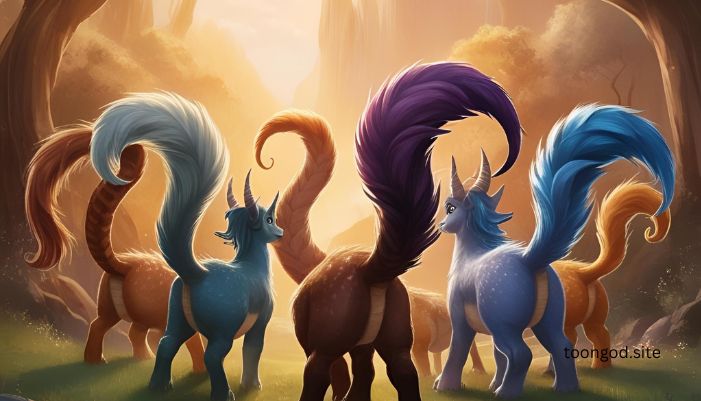Tails are an important part of many animals. They help with movement, communication, and even survival. But how much do we really know about them?
In this article, we will explore how tails work, why they are so useful, and how they help animals live and thrive. You might think tails are simple, but they do a lot more than you might expect!
Whether you’re curious about how dogs use their tails or how fish swim with theirs, this article will give you fun facts and useful information.

The Functionality of Tails in the Animal Kingdom
Tails: More Than Just a Body Part
Tails are not just extra parts of an animal. They have many jobs depending on the species. Some animals use their tails to help balance, while others use them to communicate. For example, a dog’s tail can show if it’s happy, scared, or excited. A cat might flick its tail when it’s upset, while a horse can use its tail to keep bugs away. In some animals, tails are even used as weapons, like when scorpions use their tails to sting.
In the wild, animals need their tails to help them move or stay safe. For instance, many animals use their tails to keep balanced when running or climbing. A kangaroo’s tail helps it hop by keeping its body steady. Some animals have long, strong tails that allow them to swim fast in water, like dolphins and fish. Each animal’s tail is built for the way it lives, and it’s an important tool in the survival of that species.
Tails and Communication
In addition to helping animals move and stay safe, tails are important for communication. Many animals use their tails to send messages to other animals. For example, when a dog wags its tail, it can show that the dog is happy or friendly. But if the tail is stiff or tucked between the legs, the dog might be scared or nervous.
Some animals also use their tails to warn others of danger. A squirrel might flick its tail to let other squirrels know that a predator is nearby. In some cases, tails are used for mating rituals, like when birds show off their colorful tails to attract a mate. By watching tail movements, animals can learn a lot about what other animals are feeling or what they might do next.

The Evolutionary Journey: How Tails Evolved
Early Beginnings: The First Tails
Tails have been around for a long time. They started out as simple tools that helped early animals move and stay balanced. The first animals with tails used them mostly for swimming or keeping balance on land. As animals continued to evolve, their tails changed too. Some animals’ tails grew stronger or more flexible to help them do more things, like hold on to trees or catch prey.
For example, reptiles like lizards use their tails to escape danger. If a predator grabs a lizard by the tail, the lizard can often shed its tail and escape. This is a special way that the tail helps protect the animal. Over time, more animals began to use their tails for different jobs. Some tails became prehensile, meaning they could be used like a hand to grab things.
Special Tails for Survival
As animals adapted to their environments, their tails evolved to meet different needs. For instance, animals in the ocean developed tails to help them swim. Fish have fins and tails that work together to move through the water. Dolphins use their tails, called flukes, to dive deep and swim fast.
On land, animals like kangaroos and cheetahs use their tails for balance. A kangaroo’s tail is thick and strong, helping it jump long distances. A cheetah’s tail helps it steer quickly when running fast after prey. These examples show how tails are not just extra parts of the body—they are specialized tools that have helped animals survive in different habitats.
A Tail for Every Need: Unique Tail Features Across Species
The Prehensile Tail: A Tool for Grasping
Some animals have a special kind of tail called a prehensile tail. This type of tail can wrap around objects, much like a hand can grab something. Animals like opossums, some monkeys, and certain marsupials have prehensile tails. These tails allow them to climb trees and hold onto branches, which is very helpful when living in a forest or jungle.
For example, some monkeys use their tails to grab branches while they swing through trees. This gives them more freedom to move and look for food. In this way, the prehensile tail is like a fifth limb that helps these animals live in a tree-filled environment. The tail is an important tool for climbing, staying safe, and reaching food that would be difficult to get otherwise.
Tail Flaps and Fins: How Aquatic Animals Use Tails
Animals that live in water also have special tails that help them swim. Fish, dolphins, and other sea animals rely on their tails to move quickly through water. Fish have strong, flat tails that help them move in a smooth way. The tail fin is key to their ability to swim at high speeds or change direction in the water.
Dolphins have flukes, or tail fins, that they use to dive deep into the ocean and swim fast. These tail fins are wide and strong, and they help the dolphin push water behind it to move forward. Some sea animals also use their tails to communicate. For example, a dolphin might slap its tail on the water to send a signal to other dolphins.
The Tale of the Dog: Man’s Best Friend and Its Tail
How Dogs Use Their Tails to Show Emotions
If you have a dog, you probably know that its tail is a big part of how it shows its feelings. Dogs can communicate a lot through their tails. When a dog wags its tail, it usually means the dog is happy or excited. But the way the dog wags its tail can tell you more about how it feels. A fast wagging tail might mean the dog is very excited, while a slow wag could mean the dog is unsure or nervous.
Dogs also use their tails to communicate with other animals and people. If a dog’s tail is tucked between its legs, it might be scared or anxious. When the tail is held high and stiff, it could mean the dog is feeling confident or protective. Understanding these signals helps us connect with dogs and take better care of them.
The Role of Tails in Different Dog Breeds
Different dog breeds have different types of tails, and each one serves a special purpose. For example, a Border Collie has a long, bushy tail that helps it keep balance when herding animals. The tail is very useful for the Collie’s job of running quickly and turning on a dime.
On the other hand, a Greyhound has a sleek, narrow tail built for speed. When running at top speed, a Greyhound uses its tail to steer and keep balanced. Each breed has a tail that is designed for the specific tasks that the dog does best.
Conclusion: Embracing the Diversity of Tails
Tails are fascinating and important parts of the animal world. Whether they help animals balance, communicate, or survive, tails are essential for many species. From the playful wag of a dog’s tail to the powerful fluke of a dolphin, these appendages show us how animals have adapted to their environments. The diversity of tails across the animal kingdom is a reminder of the amazing ways that nature has created solutions to challenges animals face.
FAQs About Tails
1. Why do animals have tails?
Animals have tails for many reasons. Tails help with balance, movement, communication, and defense. Each species uses its tail differently depending on its needs.
2. Do all animals have tails?
No, not all animals have tails. Some animals, like humans and birds, have lost their tails through evolution, while other species have kept them for specific purposes.
3. How do animals use their tails to communicate?
Animals use their tails to show how they feel. For example, dogs wag their tails to show happiness, while cats flick their tails when they are annoyed. Animals may also use their tails to warn others of danger or attract mates.
4. Why do some animals lose their tails?
Some animals, like certain lizards, can shed their tails when they are in danger. This gives the animal a chance to escape while the predator is distracted by the tail.
5. What does my dog’s tail mean?
A dog’s tail can show different emotions. A wagging tail usually means happiness, while a tucked tail can indicate fear or anxiety. Pay attention to the position and speed of the wagging to better understand your dog’s feelings.



